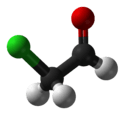Chloroacetaldehyde
| |||
| Names | |||
|---|---|---|---|
| IUPAC name
Chloroacetaldehyde | |||
| Systematic IUPAC name
Chloroethanal | |||
| Other names
2-Chloroacetaldehyde, 2-Chloroethanal | |||
| Identifiers | |||
| 107-20-0 34789-09-8 (hydrate) 7737-02-2 (hydrate) | |||
| ChemSpider | 32 | ||
| EC Number | 203-472-8 | ||
| Jmol interactive 3D | Image | ||
| PubChem | 33 | ||
| UNII | CF069F5D9C | ||
| |||
| |||
| Properties | |||
| C2H3ClO | |||
| Molar mass | 78.50 g mol−1 | ||
| Appearance | Colourless liquid | ||
| Odor | acrid, penetrating | ||
| Density | 1.117 g/mL | ||
| Melting point | −16.3 °C (2.7 °F; 256.8 K) | ||
| Boiling point | 85 to 85.5 °C (185.0 to 185.9 °F; 358.1 to 358.6 K) | ||
| soluble | |||
| Solubility | soluble in acetone, methanol | ||
| Hazards | |||
| Main hazards | alkylating agent | ||
| Flash point | 87.7 °C (189.9 °F) (closed cup) | ||
| Lethal dose or concentration (LD, LC): | |||
| LD50 (Median dose) |
89 mg/kg (oral, rat) 82 mg/kg (oral, mouse)[1] | ||
| LC50 (Median concentration) |
200 ppm (rat, 1 hr)[2] | ||
| US health exposure limits (NIOSH): | |||
| PEL (Permissible) |
C 1 ppm (3 mg/m3)[3] | ||
| REL (Recommended) |
C 1 ppm (3 mg/m3)[3] | ||
| IDLH (Immediate danger |
45 ppm[3] | ||
| Related compounds | |||
| Related compounds |
2-chloroethanol, Chloroacetic acid | ||
| Except where otherwise noted, data are given for materials in their standard state (at 25 °C [77 °F], 100 kPa). | |||
| | |||
| Infobox references | |||
Chloroacetaldehyde is the organic compound with the formula ClCH2CHO. Like some related compounds, it is highly electrophilic reagent and a potentially dangerous alkylating agent. The compound is not normally encountered in the anhydrous form, but rather as the hydrate (acetal), ClCH2CH(OH)2. Chloroacetaldehyde is a useful intermediate in the synthesis, e.g. of 2-aminothiazole or many pharmaceutical compounds. Another use is to facilitate bark removal from tree trunks.
Synthesis and reactions
The hydrate of chloroacetaldehyde is produced by the chlorination of aqueous vinyl chloride:
- ClCH=CH2 + Cl2 + H2O → ClCH2CHO + 2 HCl
It can also be prepared from vinyl acetate.[4] The related bromoacetaldehyde is prepared via bromination of vinyl acetate. It also rapidly forms a acetals in the presence of alcohols.[5]
Being bifunctional, chloroacetaldehyde is a versatile precursor to many heterocyclic compounds. It condenses with thiourea derivatives to give aminothiazoles. This reaction was once important as a precursor to sulfathiazole, one of the first sulfa drugs.[4]
Environmental aspects
Chloroacetaldehyde is a metabolite in the degradation of 1,2-dichloroethane, which initially converts to chloroethanol. This metabolic pathway is topical since billions of kilograms of 1,2-dichloroethane have been produced as a precursor to vinyl chloride.[6]
Safety
Based on data collected from human studies in 1962, exposures to 45 ppm of chloroacetaldehyde were found to be very disagreeable and caused conjunctival irritation to the subjects.[7] The Occupational Safety and Health Administration established a permissible exposure limit at a ceiling of 1 ppm (3 mg/m3) for exposures to chloroacetaldehyde.[8]
References
- ↑ "Chloroacetaldehyde". National Institute for Occupational Safety and Health. 4 December 2014. Retrieved 20 February 2015.
- ↑ "Chloroacetaldehyde". Immediately Dangerous to Life and Health. National Institute for Occupational Safety and Health (NIOSH).
- 1 2 3 "NIOSH Pocket Guide to Chemical Hazards #0118". National Institute for Occupational Safety and Health (NIOSH).
- 1 2 Reinhard Jira, Erwin Kopp, Blaine C. McKusick, Gerhard Röderer, Axel Bosch, Gerald Fleischmann "Chloroacetaldehydes" in Ullmann's Encyclopedia of Industrial Chemistry, 2007, Wiley-VCH, Weinheim. doi:10.1002/14356007.a06_527.pub2
- ↑ S. M. McElvain and D. Kundiger "Bromoacetal" Organic Syntheses 1943, volume 23, p. 8. doi:10.15227/orgsyn.023.0008.
- ↑ Janssen, D. B.; van der Ploeg, J. R. and Pries, F., "Genetics and biochemistry of 1,2-dichloroethane degradation", Biodegradation, 1994, 5, 249-57.doi:10.1007/BF00696463
- ↑ Documentation for Immediately Dangerous To Life or Health Concentrations (IDLHs)
- ↑ CDC - NIOSH Pocket Guide to Chemical Hazards

